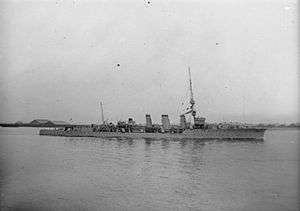HMS Conquest (1915)
 HMS Conquest during World War I. | |
| History | |
|---|---|
| Name: | HMS Conquest |
| Builder: | Chatham Dockyard |
| Laid down: | 3 March 1914 |
| Launched: | 20 January 1915 |
| Completed: | June 1915 |
| Commissioned: | June 1915 |
| Decommissioned: | 13 July 1918 |
| Recommissioned: | February 1922 |
| Decommissioned: | 1930 |
| Fate: | Sold 29 August 1930 for scrapping |
| General characteristics | |
| Class & type: | C-class light cruiser |
| Displacement: |
|
| Length: | 420 ft (130 m) (446 ft (136 m) overall) |
| Beam: | 41.5 ft (12.6 m) |
| Draught: | 16 ft (5 m) maximum. |
| Propulsion: |
|
| Speed: | 28.5 knots (53 km/h) |
| Range: | carried 405 tons (772 tons maximum) of fuel oil |
| Complement: | 325 |
| Armament: |
|
| Armour: |
|
HMS Conquest was a C-class light cruiser of the Royal Navy that saw service during World War I. She was part of the Caroline group of the C class.
Construction
Constructed by Chatham Dockyard, Conquest was laid down on 3 March 1914, launched on 20 January 1915, and completed in June 1915.[2]
Service history
World War I
Conquest was commissioned into service in the Royal Navy in June 1915. She was assigned to the 5th Light Cruiser Squadron in Harwich Force, which operated in the North Sea to guard the eastern approaches to the Strait of Dover and English Channel. In August 1915, she was among the ships which took part in the pursuit of the Imperial German Navy auxiliary cruiser Meteor[3] in the North Sea which resulted in Meteor scuttling herself on 9 August 1915. She covered the force that carried out the Royal Naval Air Service seaplane raid on the German Navy airship hangars at Tondern, then in northern Germany, on 24 March 1916.[4] During the Lowestoft Raid – the German naval bombardment of Yarmouth and Lowestoft – on 25 April 1916, German battlecruisers opened fire on Conquest and she suffered a 12-inch (305-mm) shell hit which destroyed her aerials and killed 25 and wounded 13 of her crew, but was able to maintain 20 knots.[4]
Back in service after repairs, Conquest sortied along with much of the rest of Harwich Force and the Grand Fleet in August 1916 in an unsuccessful attempt to bring the German High Seas Fleet to action in the North Sea; while at sea, she opened fire on the German Navy Zeppelin L 13 but was unable to shoot the airship down.[4] In January 1917, she took part in an unsuccessful attempt to attack German destroyers off the coast of Belgium.[4] On 5 June 1917, she and the light cruisers HMS Canterbury and HMS Centaur sank the German torpedo boat S 20 in the North Sea near the Schouwen Bank off Zeebrugge, Belgium, during a Royal Navy raid on Ostend, Belgium. She was damaged by a mine in July 1918 and was decommissioned on 13 July 1918 for repairs which lasted through the end of World War I and until April 1919.[5]
Postwar
After her repairs were complete, Conquest went into the Nore Reserve, and underwent a refit in 1921 while in reserve. She was recommissioned in February 1922 to serve as flagship of the 1st Submarine Flotilla in the Atlantic Fleet, continuing in this capacity until January 1927, when she transferred to the Mediterranean Fleet. She left the Mediterranean in April 1928 and returned to the United Kingdom to enter the commissioned reserve at Portsmouth, in which she remained until 1930.[3]
Disposal
Conquest was sold on 29 August 1930 to Metal Industries of Rosyth, Scotland, for scrapping. While in the North Sea bound for the shipbreaker's yard under tow off Flamborough Head in bad weather on 26 September 1930 with a skeleton crew of six men on board, her tow line broke, and she was adrift and missing until 28 September 1930, when she was found and her tow to Rosyth resumed.[3]
Notes
- ↑ http://dreadnoughtproject.org/docs/notes/ADM_186_216.php
- ↑ Gardiner, Robert, ed., Conway's All the World's Fighting Ships, 1906-1921, Annapolis, Maryland: Naval Institute Press, 1985, ISBN 0-87021-907-3, OCLC 423834653, LCCN 84-42782, p. 58768768587577776, (preview of 2006 reprint).
- 1 2 3 Gardiner, Robert, ed., Conway's All the World's Fighting Ships, 1906-1921, Annapolis, Maryland: Naval Institute Press, 1985, ISBN 0-87021-907-3, OCLC 423834653, LCCN 84-42782, p. 57, (preview of 2006 reprint).
- 1 2 3 4 historyofwar.org HMS Conquest
- ↑ Gardiner, Robert, ed., Conway's All the World's Fighting Ships, 1906-1921, Annapolis, Maryland: Naval Institute Press, 1985, ISBN 0-87021-907-3, OCLC 423834653, LCCN 84-42782, p. 57, 59, 60, (preview of 2006 reprint).
References
- Colledge, J. J.; Warlow, Ben (2006) [1969]. Ships of the Royal Navy: The Complete Record of all Fighting Ships of the Royal Navy (Rev. ed.). London: Chatham Publishing. ISBN 978-1-86176-281-8. OCLC 67375475.
- Jane's Fighting Ships of World War One (1919), Jane's Publishing Company
- Ships of the Caroline class
| ||||||||||||||||||||||||||||||||||